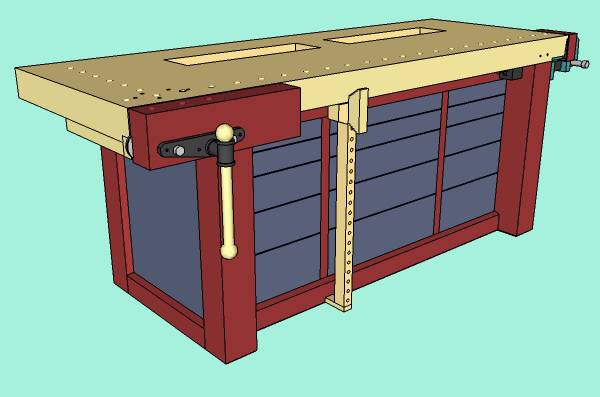Critique this design before I start cutting wood
-
I've got a big pile of southern yellow pine (a dense stiff inexpensive American "softwood") acclimating in my garage. I've been doodling plans for workbenches for over a year. I'm ready to start cutting wood.
Please take a look at the model and give me suggestions.
I have the hardware for the vises on hand and I took the measurements directly from them. The drawers in the model are dummies. They will be put in later as three individual units. The top and the legs will be laminated from construction lumber which will be planed down to ~~1.25" thick. The remaining sheet stock will be 3/4" plywood. Pocket hole screws and glue will be used where there are butt joints.
I do want a seriously solid workbench which will last approximately forever. Let me know what ideas you have. The vises are available in detailed and simplified versions in the 3D warehouse.

-
Nice.
Is it going to be stationary? All of my equipment is on wheels as my garage doubles as teacher storage
 If not you could add outlets to the bench for power tools. It is handy to have them close or on the workbench (at least for me).
If not you could add outlets to the bench for power tools. It is handy to have them close or on the workbench (at least for me).And where is the drink holder?

-
i'd be worried about having that much of the base contacting the floor.. unless your floor is perfectly flat, you're probably going to get some wobbling.. personally, i'd want to have the four legs as the only contact points..
-
Great thoughts already. The bench will be stationary and one of the reasons I chose to go with the tool tray in the middle was because I might install air or electrical power there at some point. (My first plan is to to hang air and electric over the bench on reels.)
I've gone back and forth on the form of the bottom. The location where I plan to use the bench is dead flat, and I plan to stay in that location, but who knows what the future might hold. I decided to run the cabinet all the way to the ground for three reasons:
- I am always loosing things and I wanted to eliminate the possibility of things rolling under the bench.
- The floor is solid and it seems to make sense to transfer force directly to that surface when I can.
- It's easier to build with everything oriented to one flat surface rather than the bottoms of the legs against the floor and everything else 1/4" up.
The solution I came up with at one point was to keep everything but the legs off the floor, then after the bench is on its own legs, add trim which would touch the floor. Either way, I do plan to use a "penetrating" epoxy on all floor contact surfaces so that no moisture will be drawn up.
Keep the ideas coming.
-
SchreiberBike,
Did you happen across Christopher Schwarz's book Workbenches? It is the best book on workbenches I have seen, and I think I have most of them in my library. The book is complete with very detailed plans of two old European benches (English and French). He uses yellow pine and thinks it is a great choice. Chris warns against storage under a bench and has good reasons for his argument. I think the point about the legs being the only thing touching the floor is also a good point.
Good luck with it and be sure to show us the finished product.
-
SchreiberBike,
Aahhhhh! I see you have read Chris' book. Sorry, I read that thread some time ago and didn't recall your comments on it.
I am designing a wall hanging tool cabinet for my cherished hand tools. If you know of any good books on that I would appreciate a tip.
-
I've been cutting wood for the last week or so and I have all the major pieces (legs and top) roughed out. Now I'm starting to plane the faces and selecting which ones to use where appearance matters.
I've also been testing glue-up techniques for the massive laminations. I don't have enough clamps to do it the typical way, so I plan on using screws to attach each lamination to the one before it, then unscrewing and doing the next.
I've found that a single screw creates adequate clamping force (the joint is stronger than the wood) in an oval 3" wide and 10" along the grain. That's going to be a lot of screwing, but the price is right.
-
i cannot see from the model which looks very flash... whether you have sufficient cross bracing/structural strength for it to take a good pounding as it will no doubt?
-
@tayler said:
i cannot see from the model which looks very flash... whether you have sufficient cross bracing/structural strength for it to take a good pounding as it will no doubt?
I'm confident it will take a good pounding. The top is 100mm thick and the legs are 125mm square joined together with tenons and draw-pins. Rather than rails, the back and sides will be made of 18mm plywood dadoed into the legs.
Building has not been exactly smooth. I learned a few things about adjusting and using a power planer during the process. Then I learned how important it is that each lamination have workable grain running in the same direction. That has slowed me down as I've had to buy more wood and wait for it to dry.
Every new project should be a learning experience and this has been exactly that.
Advertisement







